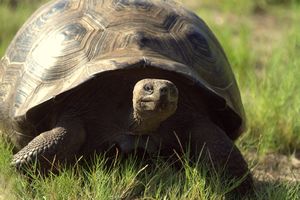Advertisement
Published: March 19th 2012

 Giant Land Tortoise
Giant Land Tortoise
One of several giant tortoises from Alcedo VolcanoThe usual call to consciousness followed by a trip to Urbina Bay, known for giant tortoises. They warned us it would be a long hike and difficult due to the lava boulders we’d be expected to scale and worse, the wasps. They failed to mention the heat and humidity. It seemed particularly steamy today, but that might have been everyone’s excitement about the potential sightings of these gentle beasts, found nowhere else but in the world.
Within five minutes of being on the track we encountered the first tortoise. He was enormous – about 200lbs and probably 100 years old. He wasn’t the biggest or the oldest guy we saw. This fellow sat just off the trail, chewing grass and occasionally looking at us with a decidedly bored expression. When he’d had enough he got up on his tiptoes, it looked like he had a hydraulic lift in his legs, and danced off into the scrub. His legs were very cool – Paul got some good shots of his toes and feet which didn’t look as if they’d be capable of moving the weight of the tortoise and with such grace, but it all worked out for the tortoise. You’d

 Tortoise Feet
Tortoise Feet
These lumbering giants have substanital foundations and evidentally no manicure facilities.expect him to be lumbering (the tortoise, not Paul) but he wasn’t; nor was he slow. He moved at a surprising clip given his size (again the tortoise, not Paul).
There were more tortoises, only one of whom took to his shell on being approached. Maybe we looked intimidating, all sweaty and swatting, but I was glad of it because we could hear the noise they take to their shell. A loud hissing. I suspected this might be a defense mechanism: sound like a snake or a deflating tire to warn enemies you mean business, but the guide explained that it was purely the expulsion of air so he could get all his bits into the shell. And did he have bits. A huge long neck that he craned and bobbed all over the place and a tail the size of a small cat as well as those muscular legs. The tail seemed to make no evolutionary sense – he didn’t use it to steer while swimming and it seemed like it would just get in the way of a hasty retreat but the guide explained that it was used only for reproduction. I felt foolish for asking. We

 Joshua
Joshua
Josh showing the effects of hiking at the equatorwere surprised to learn that tortoises can’t hear at all but everyone still whispered whenever we came across one anyway. That was instinctive.
As well as the tortoises we met some land iguanas and lots of birds too. It was a challenging walk, ending with the need to climb over 10 foot high boulders so when we got to the beach everyone was happy to dive in.
Later in the afternoon Paul and Josh went on a hike up a volcanic mountain to appreciate the geology while Adrianne and I took a Zodiac tour of the shoreline of Tagus Cove. We went into a little cave that was roiling with activity and were treated to the sight of a well choreographed feeding frenzy. Penguins chased little fish up from below while pelicans and boobies snapped at them from the surface with noddies grabbing the fish from the beaks of anyone who didn’t swallow quickly enough. It was fun chaos – noisy splashing with wings and beaks everywhere. It lasted for more than half an hour. The guide said he’d never seen this activity at that particular spot and then gave us a lesson in bait balls and feeder fish, just in case. When we go onto these Zodiacs there’s a maximum of 12 people and one guide. There’s lots of opportunity for questions and the guides are as enthusiastic to tell us about what we see as we are to hear about it.
The sheltered harbor was used as a mooring site for boats, especially pirate ships, for centuries. Someone had started the environmentally irresponsible but historically interesting habit of chiselling or painting the name of the ship and the year of the voyage in huge letters on the stone of the mountain. There were signs of ships from the 1700s and “Dove 1910” which was evidence of the successful landing of a teenager who sailed around the world in a sailboat over a hundred years ago.
Advertisement
Tot: 0.124s; Tpl: 0.01s; cc: 16; qc: 59; dbt: 0.0849s; 1; m:domysql w:travelblog (10.17.0.13); sld: 1;
; mem: 1.1mb

 Giant Land Tortoise
Giant Land Tortoise 
 Tortoise Feet
Tortoise Feet
 Joshua
Joshua